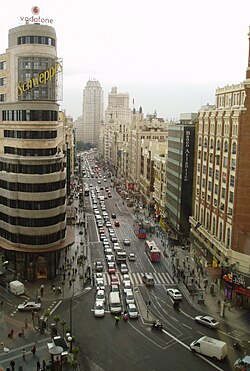Gran Vía
| Den här artikeln behöver källhänvisningar för att kunna verifieras. (2019-01) Åtgärda genom att lägga till pålitliga källor (gärna som fotnoter). Uppgifter utan källhänvisning kan ifrågasättas och tas bort utan att det behöver diskuteras på diskussionssidan. |
Gran Vía är en av de större gatorna i centrala Madrid, Spanien. Den börjar vid Calle de Alcalá och slutar vid Plaza de España. Den är ett viktigt orienteringsstråk i staden sett från kommersiell, turistisk och nöjessynpunkt.
Gatan är berömd för sina biografer. Även om några av dem har stängt under de senaste åren, har andra med stor framgång omvandlats till musikteatrar. Av detta skäl kallas stråket mellan Plaza de Callao och Plaza de España för Madrids "Broadway". Delen mellan Red de San Luis och Plaza de Callao hyser för närvarande många internationella affärskedjor inom mode.
Referenser
- Den här artikeln är helt eller delvis baserad på material från spanskspråkiga Wikipedia.
Media som används på denna webbplats
Författare/Upphovsman: Tkgd2007, Licens: CC BY-SA 3.0
A new incarnation of Image:Question_book-3.svg, which was uploaded by user AzaToth. This file is available on the English version of Wikipedia under the filename en:Image:Question book-new.svg
Författare/Upphovsman: David Adam Kess, Licens: CC BY-SA 3.0
A Black and White Photo of the the Gran Vía in Madrid Spain
below text is from the English wikipedia
Gran Vía (literally "Great Way") is an ornate and upscale shopping street located in central Madrid.Now, the street is known as the Spanish Broadway, and is one of the streets with more nightlife in Europe. It is known as the street that never sleeps. It leads from Calle de Alcalá, close to Plaza de Cibeles, to Plaza de España. The lively street is one of the city's most important shopping areas, with a large number of hotels and large movie theaters; it is also noted for the grand architecture prevalent among many of its buildings. Now, most of the theaters are being replaced by shopping malls. It is considered a showcase of early 20th century architecture, with patterns ranging from Vienna Secession style, Plateresque, Neo-Mudéjar, Art Deco and others.
In the mid 19th century, Madrid's urban planners decided that a new thoroughfare had to be created, connecting the Calle de Alcalá with the Plaza de España. The project required many buildings in the center of the city to be demolished, earning it the name of 'an axe blow on the map'. Decades after the first plans were made, construction still hadn't started and the media ridiculed the project, cynically calling it the 'Gran Vía' or 'Great Road'. Finally in 1904 it was approved and construction started a couple of years later. The last part of the street was completed in 1929.Författare/Upphovsman: Ingen maskinläsbar skapare angavs. Edescas2 antaget (baserat på upphovsrättsanspråk)., Licens: CC BY-SA 3.0
La Gran Vía desde la plaza de Callao, Madrid, España.




